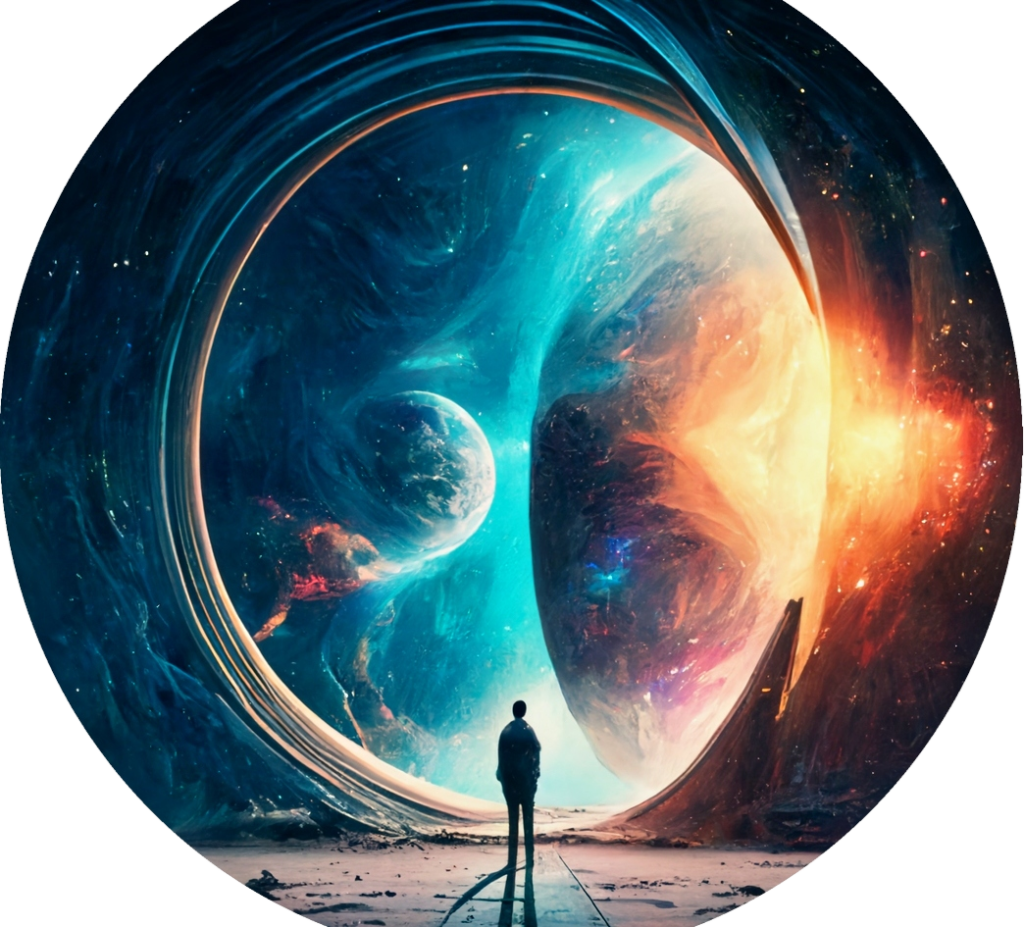Not Two: Experience, experiencer, and experienced same-same
This article addresses questions about nonduality in simple terms.
- What is the meaning of nondual/nonduality? (dualism/duality?)
- What religion believes in nonduality?
- What is non-duality in simple terms?
- What is nondualism/nonduality in Christianity?
- What does nonduality mean in Buddhism?
- What is nondualistic thinking?
- How do you practice non-dualism?
- What does the Bible say about dualism/duality and nonduality?
- What is God in dualism?
A Conceptual but Misleading Understanding of Nonduality

Nondualism, also known as non-duality, is a philosophical and spiritual belief that the universe and its components are not separate or divided entities but are one interconnected and indivisible whole. This idea of oneness transcends all dualistic concepts, such as good and evil, self and other, and subject and object.
The concept of nondualism is based on the belief that the dualistic nature of the world is an illusion and that true reality is non-dual. This is not easy to understand, but in simple terms, it means that everything is interconnected and cannot be separated from each other.
Dualism, conversely, is the belief in two separate and distinct entities or principles, such as good and evil or mind and body. Dualistic thinking creates a divide between the self and the world, whereas non-dualistic thinking sees the self and the world as one integrated entity.
In dualistic religions, such as Zoroastrianism and Manichaeism, God is seen as a separate and distinct entity from the world and its components. In contrast, in nondualistic religions, such as Hinduism and Buddhism, the concept of God is often seen as inherent in all things and not separate from them.”
What is Nonduality
Nonduality is nonconceptual. It is experiential, whereas the concept of nonduality is the opposite of the concept of duality. It is the awareness and cognition of the fundamental nature of existence (reality) as an indivisible essential oneness. This awareness reveals no authentic separation between the obvious dualities of our normal dimension of experience. Dualities are viewed as two sides of the same coin or manifestations of the same fundamental ground.
“Not Two”
From nondual perception, reality is experienced as an undividable, unbounded whole. This singularity is perceived as the ultimate truth or unchangeable reality and has been articulated differently across numerous spiritual and philosophical schools and teachings. Even with the diversity in how it has been presented, the core message remains the same: the dualistic character of the world is only an impression, and the real truth lies beyond the contrast of “two.”
“Not two” is a negation of duality. It nullifies the notion and perception of two as having any ontological separateness.. It reveals that there is no division or fragmentation in reality. It is an indivisible whole.
Nonduality says that dualities are not primary or inalienable. Rather, they are merely facets of a more profound unity that constitutes the underlying truth of reality.

“What is Non-duality in Simple Terms?”
Non-duality is the simple, clear perception that existence is not composed of separate, distinct parts but is a oneness beyond the conceptual limitations of adding parts together to form this oneness. This acknowledges that all separating boundaries are illusory and that there is no real divide between self and others, subject and object.
The notion of “not two” is the simplicity of nondual recognition and refers to the perception that reality is not divided or separated into distinct parts but is a seamless and indivisible whole. “Not two” reveals no duality or separation between things. All are of the same fundamental nature.
The concept of “not two” is central to many spiritual and philosophical traditions, including Hinduism, Buddhism, and Taoism, and is often associated with ideas of unity, oneness, and interdependence. It is a key aspect of awakening or enlightenment and a way to see beyond the world’s dualities to a more profound perception and understanding of reality.
The experience of “not two” take us beyond dualistic perspectives, where we gain an appreciation for the uninterrupted entirety of reality. This deeper outlook opens the possibility of grasping a profound comprehension of the real world and a sense of harmony and togetherness.
The nullification of duality is a significant element of spiritual illumination or enlightenment since it encourages one to inquire beyond the dualities of the universe to a more profound and inclusive understanding of reality. By accepting that dualities are not primary or inalterable, individuals can cultivate an elevated degree of tenderness and sympathy for others and acknowledge all things’ mutual dependence and interconnectedness.
What is Nondual Experience?
Nondual experience refers to a state in which a person perceives reality without dividing filters from their mind. In this experience, individuals transcend the division between themselves and the outside world, viewing them as unified, boundless, interpenetrated, and interrelated.
This profound and transformational experience changes one’s perspective of the universe and their relationship to it – there is no relationship; one is the universe.
In nondual experience, the experience of separateness between oneself and the outside world dissolves, resulting in peace, pleasure, and kindness as one understands the oneness of existence.
It is important to understand that nondual experiences are not the same as having a “religious experience” and can be experienced by anyone regardless of spiritual or belief systems. Rather, they are experiences that surpass dualistic thinking with clear insight into the nature of reality.
Nondual experiences can be seen as glimpses or instants of enlightenment, and for some people, it can cause a lasting shift in their perception and comprehension of reality.
What is the Explanation of Non-duality?
It isn’t easy to comprehend non-duality, for it requires us to go beyond the dualistic nature of the mind and language. Our mind is a comparative mind. It knows by comparing one separate, individual thing to another – objects, thoughts, people, feelings, etc. A simple perusal of the dictionary reveals the endless looping of the known, defining the known and not-known.
Nonetheless, the gist is that our reality is not fragmented into separate pieces but a continuous, integrated entirety.
In nonduality, dualistic thought is viewed as a restriction of our perception. A simple shift in perspective, which cannot be “done” from the dual, results in a profound comprehension of reality. This profound insight is referred to as nondual consciousness.
Non-duality is usually conveyed through enigmatic statements such as “not two,” or “What’s seeing is what you are seeking,” aiming to call into question dualistic ideas and instill an awareness of the underlying unity of everything.
Non-duality is not a thought or an idea. It can only be experienced as it liberates the constraints of words and comparative thoughts and concepts. By probing into present experience, we can penetrate the veils of duality.

Nonduality versus Enlightenment
“Nondual realization” and “enlightenment” are related but distinct concepts in spiritual and philosophical traditions.
Nondual realization refers to the perception or experiential understanding of reality as a oneness, a “not-two,” transcending the dualistic, comparative mind. It is a realization of reality’s underlying, fundamental nature and the absence of a separate self.
Enlightenment, on the other hand, is often used to describe a state of complete understanding and liberation from ignorance, suffering, and rebirth. In some traditions, enlightenment is seen as the ultimate goal of spiritual practice. It is associated with a deep understanding of reality, including the nature of self, emptiness, and Mind.
Nondual realization can be seen as a step or aspect of the path toward enlightenment. “Enlightenment” varies between spiritual and philosophical traditions, and the relationship between nondual realization and enlightenment also varies.
What is Dualistic vs Non-dualistic?
Dualistic refers to a mode of perception and understanding that divides reality into separate and distinct parts, such as self and other, good and evil, and so on. Dualistic thinking is based on separating the perceiver and the perceived, reinforcing the illusion of a separate self.

On the other hand, nondual perception recognizes that reality is fundamentally not divided into separate and distinct parts but is instead a seamless and interconnected whole. It transcends dualistic thinking and recognizes that everything is arising from the same source.
In practical terms, dualistic thinking often leads to a narrow and limited understanding of reality and feelings of separation and conflict. Nondual perception, on the other hand, leads to a deeper sense of interconnectedness and a more holistic understanding of reality.
What is Non-dualistic Thinking?
Non-dualistic thinking is an oxymoron as the human brain/mind is comparative – making comparisons and categorizing experiences into separate and distinct parts
Non-dualistic thinking is a mode of perception and understanding that transcends dualistic thinking. It may be more easily understood in conceptual terms as experiential perception in which thinking happens without a thinker.
Nonduality is not a static state but a dynamic process of recognizing and transcending dualistic thinking. Individuals may move back and forth between duality and nonduality thinking. The embodiment and actualization of nondual consciousness are often seen as a lifelong process of spiritual development.
Nondual awareness is not limited to spiritual or philosophical contexts.
What Religions Believe in Nonduality?
The concept of nonduality can be found in many spiritual and philosophical traditions, although it is expressed in different ways and to varying degrees. Some of the main religious traditions that embrace nonduality include:
- Hinduism – Nonduality is expressed through the concept of Advaita Vedanta, which teaches that the ultimate reality is a single, unchanging, and infinite consciousness that transcends dualities.
- Buddhism – teaches that all phenomena arise in dependence upon other phenomena and lack inherent existence. (see more below)
- Taoism – Nonduality is understood through the concept of Tao, which is seen as an underlying unity and oneness that transcends dualities.
- Sufism – Nonduality is experienced through unity with the divine, which teaches that the ultimate reality is a single, unchanging, and infinite consciousness that transcends dualities.
While these religious traditions each have unique expressions of nonduality, they all share the idea that reality is not divided into separate and distinct parts but a seamless and interconnected whole.
What does Nonduality Mean in Buddhism?”
In Buddhist philosophy, non-duality is often described as “not two.” This means that the Buddhist understanding of reality transcends the dualistic distinctions between self and other, subject and object, and so on.
The self is seen as illusory, and the nature of reality as pure spaciousness or nothingness. Clear, transparent awareness is what perceives. This mirror-like awareness is self-aware without a self as we understand it – awareness is aware of awareness.
Is Buddhism a Religion?
Buddhism can be described as a religion, philosophy, and spiritual path. It encompasses all three elements, yet its classification can be subjective and dependent on the individual’s interpretation.
Buddhism originated as a spiritual path in ancient India, where the historical Buddha taught a path to liberation from suffering. It later evolved into a comprehensive philosophical and ethical system, incorporating meditation, mindfulness, ethics, and metaphysical elements. In this sense, it can be seen as a philosophy.
However, for many people, Buddhism is also a religion, as it encompasses a set of beliefs and practices that center around the veneration of the Buddha, the study and application of Buddhist teachings, and the pursuit of spiritual liberation. It includes a rich tradition of rituals, festivals, and devotional practices and is often associated with a particular community of believers and institutions.
Ultimately, how one categorizes Buddhism may depend on one’s personal beliefs and practices. Regardless of the label, Buddhism remains a powerful and enduring spiritual tradition, offering a path to liberation, inner peace, and wisdom.
What is Nondualism/Nonduality in Christianity?

Nondualism or nonduality in Christianity is a concept that recognizes the unity and interconnectedness of all things, even within a Christian context. While traditional Christian teachings often emphasize the distinction between God and creation, nondual Christianity recognizes that this distinction is not absolute but rather a reflection of the limitations of human understanding.
Nondual Christianity expresses non-duality through the concept of the “divine spark or spirit” within all things, which recognizes that all things, including humans, are connected to the divine. This idea is often seen as a way to reconcile the dualistic thinking found in traditional Christian teachings with a nondual understanding of reality.
This Christian interpretation of nonduality doesn’t appear to approach the level of “not two,” as the soul and God are seen as separate. A “connection” with the Divine reflects two, not “not two.” The oneness of the soul and God is found in the esoteric writings of Christian mystics, many of whom fell afoul of the Church and traditional Christianity.
What does the Bible Say About Dualism/Duality and Nonduality?
The Bible contains dualistic and nondualistic elements, and its teachings can be interpreted in both dualistic and nondualistic ways.
In the Old Testament, there are dualistic concepts such as the separation of light and darkness, good and evil, and heaven and hell. These dualistic concepts suggest a division between opposite forces and a clear distinction between good and evil.
In contrast, the New Testament contains “a blush” of nondualistic teachings emphasizing the unity and interconnectedness of separate things. For example, Jesus taught the concept of the “Kingdom of God,” in which all things are united, and the idea of the Holy Spirit as a unifying force in the world.
In Christian mysticism, nondualism focuses on the unity of the soul with God. Nonduality is often linked to the experience of divine union or mystical union, in which the individual experiences a sense of unity with God and the world.
The concept of divine union can still maintain a sense of duality. Rarely do you read of the soul recognizing itself as God. The Bible can be interpreted in different ways, and different Christian traditions may emphasize different aspects of dualism and nondualism in their teachings.

Christian Mysticism and Nonduality
Saint John of the Cross’s “Dark Night of the Soul” concept can be seen as an expression of nonduality.
In his writings, Saint John of the Cross describes the “Dark Night of the Soul” as a spiritual experience in which the individual must let go of their attachment to worldly things and their ego to deepen their connection with God. This process is often described as a painful and difficult experience and a necessary step toward a deeper spiritual realization.
The “Dark Night of the Soul” can be interpreted as a nondual experience in which the individual transcends their dualistic nature and realizes the unity of all things. By letting go of their attachment to their ego and worldly things, the individual moves beyond the dualistic separation of self and God and experiences a sense of unity and oneness with the divine.
In this sense, the “Dark Night of the Soul” can be seen as a spiritual awakening in which the individual moves beyond dualistic thinking and experiences a more profound sense of unity with the divine.
Meister Eckhart, a German medieval Christian mystic and theologian, can be seen as a proponent of non-dualism.
Meister Eckhart emphasized the unity of the individual self with God and the idea that the self and God are essentially the same. He taught that the individual self is a spark of the divine and that the ultimate goal of the spiritual journey is to realize this unity and to return to the divine source.
Meister Eckhart’s teachings can be seen as Christian nondualism. The dualistic separation between self and God is transcended, and the individual experiences a sense of unity and oneness with the divine. He emphasized that the self and God are not separate entities but that the self is an expression of the divine and that the ultimate goal of the spiritual journey is to realize this unity.
There have been other Christian mystics who can be considered proponents of non-dualism. Here are a few examples:
- Julian of Norwich – An English anchorite and mystic who emphasized the idea of the divine indwelling in all things and the unity of all things in God.
- Teresa of Avila – A Spanish mystic, writer, and reformer who, like St. John of the Cross, wrote about the spiritual journey and the idea of union with God.
- St. Bonaventure – An Italian Franciscan friar and theologian, who wrote about the idea of the “Divine Word” as the underlying unity and source of all things, and the ultimate goal of the spiritual journey.
- Henry Suso – A German Dominican friar, mystic, and writer, who, like Meister Eckhart, emphasized the unity of the individual self with God and that the self and God are essentially the same.
These mystics, like Meister Eckhart and St. John of the Cross, can be seen as proponents of Christian nondualism. Their teachings continue to influence contemporary discussions of spirituality and mysticism within the Christian tradition.
Islam and Nonduality
The concept of non-duality is not central to Islam, but some Sufi mystics have discussed and interpreted it within the Islamic tradition. Sufism, often referred to as the mystical branch of Islam, emphasizes the direct experience of God. Some Sufi mystics have spoken about the unity of the individual self with the divine, similar to nonduality.
For example, the 13th-century Persian Sufi poet Rumi wrote extensively about the unity of the self with the divine and the idea that the self and God are essentially the same. Another example is the 12th-century Persian Sufi thinker and writer Abu Hamid al-Ghazali, who wrote about the individual self merging with the divine in complete unity and oneness.
Non-duality is not widely accepted or emphasized within Islam. Some interpretations of Islam reject the idea of the unity of the self with the divine, as they see it as pantheistic or heretical.

Quotes on Nonduality
- Abu Hamid al-Ghazali: “The truth is that there is nothing but God. When you see things as separate, it is due to the limitations of your own perception.”
- Saint John of the Cross: “The center of our soul is where God and the soul meet and infuse each other, where God and I become one, not by way of confusion of substance, but by transforming union.”
- Meister Eckhart: “The eye with which I see God is the same eye with which God sees me.”
- “That which is called the spirit is not different from space. The space within the heart and the space outside are the same.” – The Upanishads, c. 800-400 BCE.
- “The Tao that can be spoken is not the eternal Tao.” – Tao Te Ching, c. 600 BCE.
- “The One remains, the many change and pass; Heaven’s light forever shines, Earth’s shadows fly.” – Marcus Aurelius, Meditations, c. 170 CE.
- “I am He whom I love, and He whom I love is I. We are two spirits dwelling in one body.” – Hadith, c. 8th century.
- “The Sufi is he who has seen himself in all and all in himself.” – Al-Hallaj, c. 857-922.
- “Form is emptiness, emptiness is form.” – Heart Sutra, Mahayana Buddhism.
- “All things are marked with Self; the self is unmarked.” – Udana, Theravada Buddhism.
- “The duality of ‘I’ and ‘mine’ is the root of all suffering.” – Dhammapada, Theravada Buddhism.
- “The nature of all things is emptiness, like an illusion.” – Nagarjuna, Madhyamaka Buddhism.
- “The two sides of a coin are not separate; they are inseparably connected.” – Longchenpa, Dzogchen Buddhism.
- “The Self is one, without a second.” – Adi Shankara, c. 788-820.
- “The Atman [Self] and Brahman [Absolute Reality] are not two, but the same.” – Ramana Maharshi, c. 1879-1950.
- “There is no other than the Self, who shines as consciousness in all.” – Anandamayi Ma, c. 1896-1982.
- “The essence of the world is pure consciousness, without duality.” – Nisargadatta Maharaj, c. 1897-1981.
- “In the Self, all dualities disappear.” – Sri Nityananda, c. 1900-61.
- “The duality of the world is a mere appearance.” – Sri Ramakrishna, c. 1836-1886.
- “You are not a drop in the ocean. You are the entire ocean in a drop.” – Rumi.
- “I have no religion, my faith is in love. I have no caste, my grace is humanity.” – Mirabai, a 16th-century.
- “All things are permeated with God, just as all things are permeated with air.” – Hildegard of Bingen, a 12th-century Christian mystic.
- “The soul that is fully realized in God neither loves nor hates anything created, for she is beyond all created things.” – Teresa of Avila, a 16th-century Spanish mystic
- “The one who realizes the self is not two, but one with all that exists.” – Amma
- “The separation between you and everything else is an illusion.” – Eckhart Tolle.
- “Non-duality is the recognition that everything is one undivided whole.” – Mooji.
- “Non-duality is not a destination but a recognition of our true nature.” – Adyashanti.
- “The duality of the world is created by the mind and disappears in the absence of thought.” – Toni Packer.
- “The universe is a seamless, infinite, unchanging oneness, beyond time and space.” – Rupert Spira.
- “In non-duality, there is only the present moment, and in that moment, there is no separation between the observer and the observed.” – Paul Hedderman.
The Diamond Approach and Nonduality

The Diamond Approach, developed by A. H. Almaas, is often described as a nondual approach to spirituality and self-discovery. The teachings of the Diamond Approach are based on the idea that there is a universal wisdom that transcends dualistic thinking, which can be discovered through self-investigation and inquiry. The approach emphasizes the direct experience of one’s true nature, which is said to be beyond concepts of self and other, and to embody the qualities of love, peace, and awareness. In this sense, the Diamond Approach can be seen as an expression of nonduality. It recognizes all things’ ultimate unity and aims to help individuals experience this unity directly.
In non-duality, there is no separation between the observer and the observed. The duality of subject and object is transcended, and there is only the pure, unmediated experience of reality. – A. H. Almaas.

